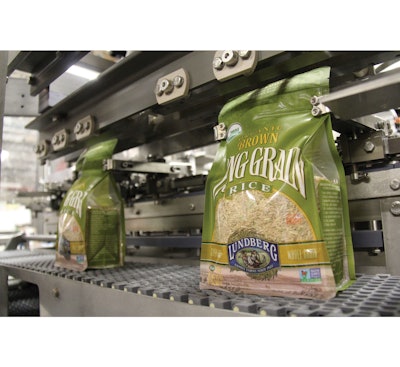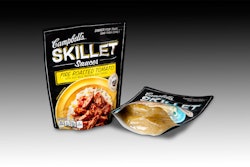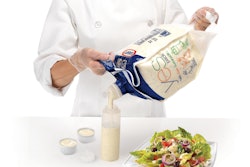Rice packaging may not be considered especially innovative, but that impression is likely to change with the recent launch of a new stand-up pouch from Lundberg Family Farms. The premade bags from Peel Plastic Products employ Velcro Industries’ Velcro® PRESS-LOK™ closure technology. Bags are filled and sealed on a Robert’s Packaging Intermittent-Motion Fill Seal (IMFS) 1500 machine from Alliedflex Technologies.
The PRESS-LOK system is a proprietary hook-to-hook technology. The closure system contains an easy alignment that allows the hooks to engage without precise line-up, securing closure with great burst strength to maintain the package integrity. Instead of needing to perfectly align zippers, consumers can easily engage the PRESS-LOK closure by pressing the two sides together.
Founded in 1937, Richvale, CA-based Lundberg Family Farms is a third-generation family firm that produces a variety of organic and eco-farmed rice products, including packaged and bulk rice, rice cakes, rice chips, risottos, couscous, pasta, rice syrup, and flour that are available throughout the U.S. and Canada at natural foods stores, conventional supermarkets, and club stores.
Todd Kluger, vice president of marketing, explains, “My job is to make sure that I am looking at the trends in the marketplace and understanding what consumers desire. I noticed a change happening within the grain section of grocery stores in which many brands were going from layflat pouches to stand-up pouches. Lundberg Family Farms had been in layflat packs for quite a few years.”
Meanwhile, rice packaged in traditional bag-in-box formats was also loosing appeal. Kluger notes, “A lot of consumers turned against this packaging because actually they want to see what the grains look like. It’s a psychological thing for them to make sure that the rice looks clean. But instead of just going to what consumers were already purchasing, and being satisfied with what other brands had already done, we wanted something new. Research showed that consumers wanted to be able to reclose the pouch, and that retailers wanted a pack that would stand up and not collapse on the shelf.” That can be a concern, he says, because grains are weighty and tend to bulge out in the center of a pack and cause it to topple over in a bottom-gusseted pouch because of their center of gravity.
Not your parents’ Velcro
The company diligently pursued packaging that would meet the diverse needs of consumers, retailers, and its own internal operations. At a recent trade show, Lundberg representatives spoke with Peel Plastics, discovering an appealing pack on the supplier’s Web site. But Lundberg wanted to make sure it considered consumer research indicating zippers were sometimes challenging to line up and reclose.
“We respect both our older consumers and our younger consumers,” says Kluger, “so we had to make sure that they would have something that they could close easily, that had good usability, and that also looked beautiful. Peel recommended this new technology from Velcro Industries called PRESS-LOK. My initial concern was, ‘Wow, VELCRO, isn’t that a material with one side that’s hairy and the other side sticks to it? This won’t work in food applications.’ And Peel said, ‘Trust us’. They sent us samples and we were immediately impressed. It didn’t have the little hairs of the past and it was perfectly food-safe.”
Once Lundberg decided to move forward with the Peel/Velcro solution, “it came together very fast,” says Kluger. “We were able to go from concept to fruition and get product onto store shelves within six months. We started filling rice in the package last September.”
Following the process
Peel converts the pouches with the Velcro®-brand PRESS-LOK closure technology. The finished 4.25-mil pouch structure comprises 48-ga PET/3.75-mil ethylene vinyl alcohol/coextruded sealant. BPA-free, the bags are marked with a number 7 recycling code.
The premade pouches are sent to Lundberg where the Roberts IMFS 1500 uses suction to select one bag at a time off of a conveyor on the U-shaped line. The machine also uses suction to open the bag and then shoots a burst of air into the pouch to open it and blow out any possible particles.
As the pouches index around a starwheel, rice is deposited into the top of the open pouch, which is subsequently heat-sealed prior to exiting the machine for manual packaging into shipping cases. Pouches index through a heat-sealing station, proceeding to the end of the conveyor for downstream hand packing into shipping cases.
Products have a one-year shelf life. “After opening we recommend refrigerating the packs to extend shelf life with whole grain rice as there is some oil content to rice because of the bran layer,” says Kluger.
The line runs 24 hr/day, five or six days a week, at about 50 bags/min. The new bag did require an investment in new equipment—the Roberts machine. “We’re very happy with it,” says Kluger, “and we’re putting in a second identical line. The machine efficiency matches that of previous equipment we had for our former packaging.”
How did Lundberg learn about Roberts machinery? Kluger says it was both from trade-show visits and hearing from other companies that had pouching operations. “We went and researched and did our due diligence on what was the best machinery that we could find to accomplish our task,” says Kluger.
The equipment now fills 23 different SKUs, including four different sizes: 8-oz, 1-lb, 2-lb, and 4-lb versions. “All are packed on the same piece of machinery,” Kluger notes.
Benefits of new packaging
The new package provides market differentiation for Lundberg. Kluger adds, “The initial competitive advantage is with the redesign—the new package now stands out. Its five sides give us ample space to tell our story about our farming operations, our family, the quality of the rice, and the varieties. We enjoy better shelf presence, and moving from layflat to standing up will hopefully even introduce us to new consumers.
“The packaging does give us a competitive advantage in that it’s now a true flat bottom, which makes retailers much happier. They can now position two bags on the shelf for every one bag of ours they could before. And some of the retailers had set their shelves very tight when it came to the height because they would stack only a few layflat bags on top of each other. So, we had to work with the retailers to make sure that the new stand-up pouch starts flowing through into their stores and that the shelf height was going to be correct for it. We have had great support from the smaller retailers all the way up to the larger retailers we work with.
“The easy-to-reclose feature makes consumers happy. Now they are able to store their rice a lot easier and not end up with an accident or spill in their cupboards. Our former bags didn’t have any way to reclose and people would reseal the bag themselves with different sorts of closures, clips, or by rolling over the bag top a couple of times and putting a rubber band around it.”
Kluger credits Portland design firm Anton Kimball Design with developing the eye-catching, informative graphics for the new pack. “They researched our family history, our packaging history, how the brand has changed over the years, and our connection to natural and organic, and they took us to a new level of beautiful design that’s pleasing to the eye for the consumer and makes it easier to display the product.”
Kluger says, “There is a slight increase [in product cost] because the package is delivering a value to the consumer. The price difference in the packaging itself is about 15 percent, but the retail price will go up only about five percent, depending on the product variety and the retailer.”
So how does Lundberg justify the economic investment in the new packaging and two new packaging lines? “It’s simple, says Kluger. “We have to invest in our future. Even in a down economy companies have to invest in their futures. Even though it would be very easy to say the package we had was working fine, if you do not continue to innovate, you will begin to lose some of your market share because your competitors are going to innovate.
Lundberg is an organic, natural, gourmet brand, and we actually are higher-priced than the mainstream and generic grains in the marketplace. Consumers actually expect us to continue to innovate. We will lose those consumers if we don’t.”





























